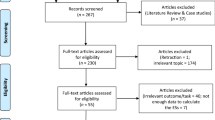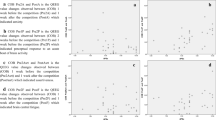Abstract
Neurofeedback may be useful for improving sports performance but few studies have examined this potential. Here we present data of five development players from a major league baseball team. The aims were to evaluate the feasibility of conducting sessions within a professional organization, assess changes in quantitative electroencephalograph (QEEG), NeuroPerformance Profile™, and report qualitative self-report data before and after brain training. The EEG was recorded with 19 electrodes for 20 min of baseline conditions and approximately 21 min of a continuous performance test. The fast Fourier transform analysis provided average cross-spectral matrices for bands delta (1–3.5 Hz), theta (4–7.5 Hz), alpha (8–12 Hz), low beta (13–16 Hz), beta 1 (13–21 Hz), beta 2 (22–32 Hz), and gamma (32–45 Hz) from the pre and post intervention evaluations in the baseline condition of eyes open. The continuous performance test metrics included the errors of omission, errors of commission, response time and response time variability. The 9 scales of the NeuroPerformance Profile™ were examined. The QEEG data, CPT data and NeuroPerformance Profile™ data were all compared between the pre and post 15 sessions of brain training using a within subject paired t test design corrected for multiple comparisons using false discovery rate method. Following brain training, comparative QEEG, CPT and NeuroPerformance Profile™ analyses illustrated significant differences. The QEEG findings of all participants illustrated significant changes within the training parameters but also across other frequency bands and electrode sites. Overall, the positive findings in both objective and subjective measures suggest further inquiry into the utility of brain training for performance enhancement with the specific application of sport is warranted. Particularly QEEG and CPT gains were noted in the areas that correspond to client self-report data demonstrating improvement in attention, decreased intrusive thought patterns and improvements in sleep patterns.







Similar content being viewed by others
References
Arns, M., de Ridder, S., Strehl, U., Breteler, M., & Coenen, A. (2009). Efficacy of neurofeedback treatment in ADHD: The effects on inattention, impulsivity and hyperactivity: A meta-analysis. Clinical EEG and Neuroscience: Official Journal of the EEG and Clinical Neuroscience Society, 40, 180–189.
Arns, M., Kleinnijenhuis, M., Fallahpour, K., & Breteler, R. (2007). Golf performance enhancement and real-life neurofeedback training using personalized event-locked EEG profiles. Journal of Neurotherapy, 11, 11–18.
Baumeister, J., Reinecke, K., Liesen, H., & Weiss, M. (2008). Cortical activity of skilled performance in a complex sports related motor task. European Journal of Applied Physiology, 104, 625–631.
Benjamini, Y., & Hochberg, Y. (1995). Controlling the false discovery rate: A practical and powerful approach to multiple testing. Journal of the Royal Statistical Society, Series B (Methodological), 57, 289–300.
Cannon, K. B., Sherlin, L., & Lyle, R. R. (2010). Neurofeedback efficacy in the treatment of a 43-year old female stroke victim: A case study. Journal of Neurotherapy, 14, 107–121.
Deeny, S. P., Haufler, A. J., Saffer, M., & Hatfield, B. D. (2009). Electroencephalographic coherence during visuomotor performance: A comparison of cortico-cortical communication in experts and novices. Journal of Motor Behavior, 41, 106–116.
Genovese, C. R., Lazar, N. A., & Nichols, T. (2002). Thresholding of statistical maps in functional neuroimaging using the false discovery rate. NeuroImage, 15(4), 870–878. doi:10.1006/nimg.2001.1037.
Harung, H. S., Travis, F., Pensgaard, A. M., Boes, R., Cook-Greuter, S., & Daley, K. (2011). Higher psycho-physiological refinement in world-class Norwegian athletes: brain measures of performance capacity. Scandinavian Journal of Medical Science in Sports, 21, 32–41.
Hillman, C. H., Apparies, R. J., Janelle, C. M., & Hatfield, B. D. (2000). An electrocortical comparison of executed and rejected shots in skilled marksmen. Biological Psychology, 52, 71–83.
Kim, J., Lee, H. M., Kim, W. J., Park, H. J., Kim, S. W., Moon, D. H., et al. (2008). Neural correlates of pre-performance routines in expert and novice archers. Neuroscience Letters, 445, 236–241.
Landers, D., Petruzzello, S., Salazar, W., Crews, D., Kubitz, K., Gannon, T., et al. (1991). The influence of electrocortical biofeedback on performance in pre-elite archers. Medicine and Science in Sport and Exercise, 23, 123–129.
Lofthouse, N., McBurnett, K., Arnold, L. E., & Hurt, E. (2011). Biofeedback and neurofeedback: Treatment for ADHD. Psychiatric Annals, 41, 42–48.
Othmer, S. (2008). The role of the continuous performance test. [Web Site] Retrieved from http://www.eeginfo.com/qiktest/cpt_qiktest.pdf.
Pascual-Marqui, R. D., Michel, C. M., & Lehmann, D. (1994). Low resolution electromagnetic tomography: A new method for localizing electrical activity in the brain. International Journal of Psychophysiology, 18, 49–65.
Sherlin, L. H., Arns, M., Lubar, J. F., Heinrich, H., Kerson, C., Strehl, U., et al. (2011). Neurofeedback and basic learning theory: Implications for research and practice. Journal of Neurotherapy, 15, 292–304. doi:10(1080/10874208),2011,623089.
Sherlin, L. H. & Hixson, B. (2011). NeuroPerformance Profile (Version 1.0) [Computer Software]. Los Angeles, CA.
Storey, J. D. (2002). A direct approach to false discovery rates. Journal of the Royal Statistical Society: Series B, 64(479–498), 2.
Storey, J. D., Taylor, J. E., & Siegmund, D. (2004). Strong control, conservative point estimation, and simultaneous conservative consistency of false discovery rates: A unified approach. Journal of the Royal Statistical Society: Series B, 66, 187–205.
Storey, J. D., & Tibshirani, R. (2003). Statistical significance for genome-wide experiments. Proceeding of the National Academy of Sciences, 100, 9440–9445.
Thompson, T., Steffert, T., Ros, T., Leach, J., & Gruzelier, J. (2008). EEG applications for sport and performance. Methods, 45, 279–288.
Yekutieli, D., & Benjamini, Y. (1999). Resampling-based false discovery rate controlling multiple test procedures for correlated test statistics. Journal of Statistical Planning and Inference, 82(1–2), 171–196. doi:10.1016/S0378-3758(99)00041-5.
Author information
Authors and Affiliations
Corresponding author
Rights and permissions
About this article
Cite this article
Sherlin, L.H., Larson, N.C. & Sherlin, R.M. Developing a Performance Brain Training™ Approach for Baseball: A Process Analysis with Descriptive Data. Appl Psychophysiol Biofeedback 38, 29–44 (2013). https://doi.org/10.1007/s10484-012-9205-2
Published:
Issue Date:
DOI: https://doi.org/10.1007/s10484-012-9205-2




